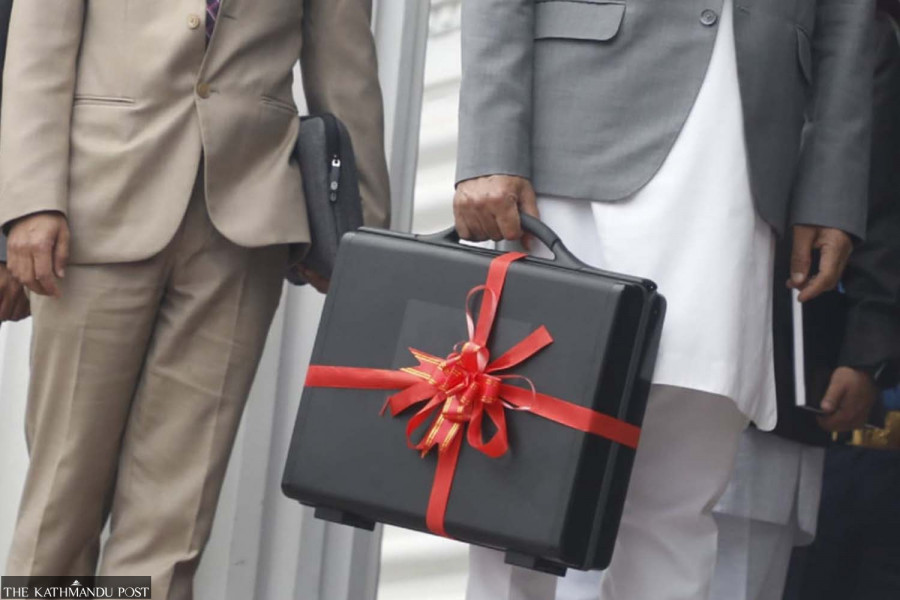
If the size of the budget is big, prices will rise; this is the truth.
A bloated budget overtaxes, overspends and overpromises. When the government expands the budget, it has to raise taxes because it needs more money, thereby leading to a rise in prices of commodities, which creates tax-inflation.
As the countdown for the next fiscal year's budget has begun, economists have warned of dangerous inflation, which could lead the country to stagflation if the annual financial plan is not introduced tactfully and carefully or if it is election-focused.
In economics, stagflation or recession-inflation is a situation where inflation hovers at high levels, the economic growth rate slows, and unemployment remains steadily high.
Amid a looming economic crisis, economists say the government should adhere to the policy of “Ghaanti heri haad nilnu”, metaphorically meaning to cut your coat according to your cloth.
The ruling coalition of five disparate parties, except the CPN (Maoist Centre), has made many promises in the election manifestos they issued before the local elections, and this will obviously require a big budget.
As per a constitutional provision, the government must present the annual budget statement on May 29 this year.
The proposed government expenditure ceiling for the next fiscal year 2022-23 beginning July 17 is around Rs1.74 trillion, about 7 percent bigger than that of the current fiscal year’s budget, according to Ram Kumar Phuyal, a member of the National Planning Commission.
“More spending is not the answer to the current problem. Inflation is the number one issue facing our country. When inflation rises, the cost of living goes up," said economist Dadhi Adhikari. “There are hundreds of discussions, seminars, meetings and round-table conferences taking place on the eve of the budget. None of the forums is talking about inflation. That’s worrying because inflation does not touch the lives of the people who frame the policy. It’s only the poor people who suffer.”
“This is a policy disorder. High inflation, in short, tends to worsen inequality or poverty because it hits the incomes and savings harder for poorer or middle-income households. Even in the United States and Europe, inflation has become a major headache, he added.
Poverty and inflation have a close relationship.
“If the government brings a bloated budget instead of addressing this problem, it will increase the economic pressures on millions of families who are already suffocating in high inflation,” Adhikari told the Post.
Based on current trends, there are numerous reasons to believe that the high rate of inflation in Nepal will not cool anytime soon. Prices of oil, both edible and non-edible, are already at record levels. Transport fares, cargo charges, vegetable prices, restaurants bills, and the cost of milk, lentils and rice are already at all-time high.
In a country where inflation is high, investors won't invest, people won't spend and market confidence sinks to new lows; and this erodes the real value of the local currency.
According to the World Bank, the rising prices may shave Nepal’s economic growth by an estimated 0.2 and 0.6 percentage points respectively in the current fiscal year 2021-22 and the next fiscal year 2022-23 from previous projections.
Nepal's inflation is already at an alarmingly high level, reaching a near six-year high in the third quarter of the current fiscal year ended mid-April.
After Covid, the inflated prices of goods and services have dealt a severe blow to the country.
The government has stopped the import of some goods which it considers “luxury” to stop further depletion of dangerously low foreign currency reserves. But this policy has created shortages of goods in the market. Prices are skyrocketing.
This year, the country’s paddy output saw an 8.74 percent year-on-year drop to 5.13 million tonnes despite a normal monsoon. Last week, India banned exports of wheat, except to its neighbours, which may put pressure on prices further.
In 2020 and 2021, the country’s economy was devastated by the Covid-19 pandemic. Nepal’s economy went into negative territory in fiscal 2019-20, and the following year saw a meagre growth rate.
Declining foreign exchange reserves, low capital expenditure, and a ballooning balance of payments deficit due to soaring imports and decreasing remittances—all these economic indicators paint a challenging picture.
The government will be unveiling its annual financial plan against this critical backdrop.
On Tuesday, it released its principles and priorities for the budget which acknowledges the challenges the country’s economy is facing currently.
“The trade deficit has been rising for several years. Inadequate domestic production and rising imports of daily essentials have emerged as challenges of the economy,” the Principles and Priorities for the Appropriation Bill said.
“So it is essential to take the country towards self-reliance by reducing imports gradually and promoting exports.”
As massive imports and inflation brought by the imports are causing trouble to the economy, the government imposed a complete ban on the import of 10 items including vehicles; alcohol; cigarettes and tobacco products; snacks like Lay’s potato chips and Kurkure; diamonds; and expensive mobile phones and television sets till the end of the current fiscal year.
But controlling imports of these items, which are major revenue generators, was a risky move as it reduced the government’s tax collection.
The inflationary burst Nepalis experienced this year was driven by a surge in demand as soon as Covid caseloads receded.
“This is the time to take an unpopular decision by considering the current economic situation including inflation, fiscal deficit, trade deficit and declining foreign currency reserves,” said former minister and finance secretary Bidyadhar Mallik. “An expansionary budget was necessary in the last two fiscal years for the economy to recover from the impact of Covid-19. Now, it is time for fiscal control.”
Considering the continued impact of Covid-19 and the election year, according to Mallik, a balanced budget is necessary which will support economic growth and not worsen the current inflationary pressure.
On the revenue front, he suggested not continuing the complete ban on the import of goods as it could lead to smuggling and result in reduced government revenue when the country is facing a fiscal deficit.
“The government can increase the duty to the maximum as provided by the World Trade Organisation to discourage imports of luxury items to prevent anomalies that can be created by an outright ban,” he said.
Against an already turbulent backdrop of global inflationary pressures amid rising food and energy prices and disrupted supply chains following the coronavirus pandemic, the war between Russia and Ukraine that started in late February is exacerbating supply and demand tensions, threatening global economic growth, including in Nepal.
The war has entered its third month and its fallout is becoming clearer for least developed countries like Nepal.
Economists say the outlook does not look good. Because of surging prices of petroleum products, food items and metals in the global market, the external sector of the economy is expected to remain vulnerable in the next fiscal year too.
Despite the challenges, experts say the government would be more inclined to introduce a distributive budget because of the election year. The local elections were held on May 13 and provincial and federal elections are scheduled for later this year.
Increasing social security spending, budgets for projects chosen by lawmakers and high election expenses may require a larger budget.
Economist Jagadish Chandra Pokharel said that in an election year, there is a risk of political interests guiding economic policies.
“The government, obviously, is in a tight spot because it has been forced to ban imports of high revenue generating items while having to introduce populist programmes to win the elections,” said Pokharel, a former vice-chairperson of the National Planning Commission.
There are concerns among economists that the government may opt for a large budget with lots of populist programmes despite the economy being in a vulnerable situation.
Their fear is also valid considering that the ruling parties have made many promises in their local election manifestos.
For example, the Nepali Congress, which is leading the ruling coalition, has promised lots of social schemes besides lowering the eligibility age for the elderly allowance to 65 years from the current 70 years under its slogan "Kokh dekhi shok samma" or "from womb to tomb".
The implementation of these announcements will require a big budget.
Finance Minister Janardan Sharma had presented an annual financial plan of Rs1.63 trillion for the fiscal year 2021-22. But he had to trim the budget by 5.3 percent after realising that the government wouldn't be able to spend the money set aside for this fiscal year.
This is the third consecutive year that the budget has had to be revised downwards. However, this experience has not stopped the government from introducing a budget which helps the ruling parties politically.
“We have seen the example of Sri Lanka where politically guided policies instead of fiscal discipline resulted in an economic disaster,” said Pokharel. “The government should use the narrow window for populist programmes because it is an election year.”
Economists have also warned that Nepal is heading in the direction of Sri Lanka if it has not already reached such a situation.
Nepal’s foreign exchange reserves have been declining from the beginning of the current fiscal year, dropping by 18.2 percent to $9.61 billion in mid-April 2022 from $11.75 billion in mid-July 2021, according to the central bank’s statistics.
The government will be forced to borrow more to address the resource deficit which will increase the debt which has grown massively in the last five years.
The country’s debt to GDP ratio is over 40 percent as of the second quarter of the current fiscal year against Sri Lanka’s 119 percent of GDP in 2021, according to the International Monetary Fund.
“As there is still space for increasing the debt, we should borrow but sensibly and at a lower interest rate only,” said Pokharel. “We have to be careful about who the creditors are. International donors like the World Bank, Asian Development Bank and International Monetary Fund don’t provide credit by going against economic rules.”
The shock waves from the Russia-Ukraine conflict will continue to reverberate around the globe, including Nepal, with the World Bank lowering its global growth forecasts.
According to a World Bank report titled "South Asia Economic Focus Reshaping Norms: A New Way Forward" released last month, transportation prices, construction costs and other consumer prices are rising which will dampen overall demand.
Nepal’s economy is expected to grow by 3.7 percent in the current fiscal year and 4.1 percent in the next fiscal year, according to the World Bank’s projection.
But the country’s official number cruncher—Central Bureau of Statistics—has projected a growth rate of 5.8 percent for this fiscal year, which many economists doubt is achievable, saying it was “cherry picking” data when the country and its citizens are suffering.
“The results of the local elections show that being populist alone does not win elections,” said Pokharel.
“It was suggested that those who supported the endorsement of the Millennium Challenge Corporation Compact would suffer in the elections. But the Nepali Congress which backed the American aid programme is doing well in the elections. So it is a myth that populist budgetary programmes are for electoral benefits alone.”













